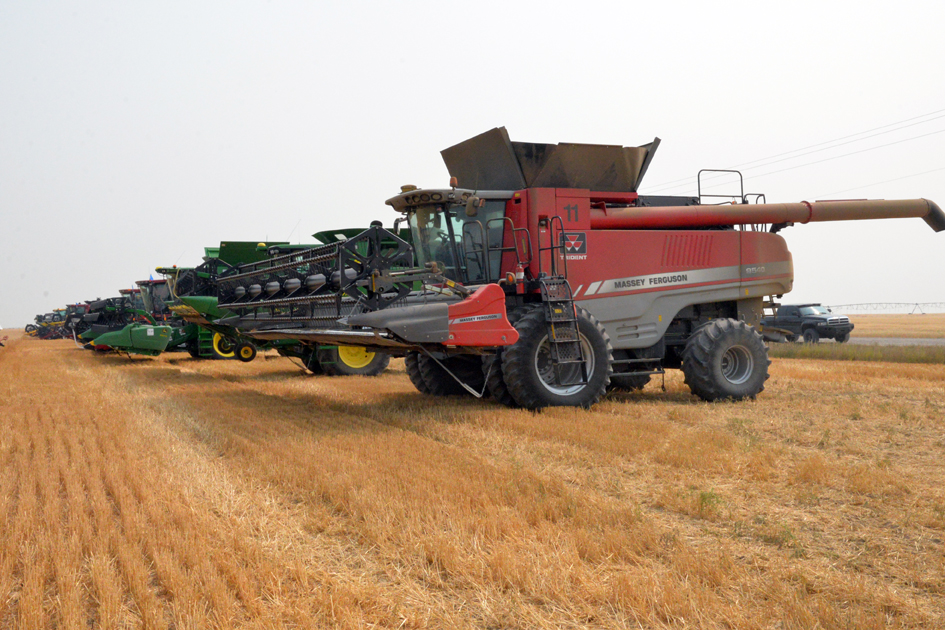Current Temperature
24.9°C
Taber/Vauxhall regions hit by hail
Posted on June 25, 2020 by Vauxhall Advance ADVANCE FILE PHOTO
ADVANCE FILE PHOTOBy Trevor Busch and Cole Parkinson
Vauxhall Advance
Southern Alberta is still assessing the damage from the June 13 storm system that shredded crops and damaged homes and property throughout the region.
The large weather system moved through Alberta bringing widespread severe thunderstorms to much of the province.
Southern regions were hit from approximately 5-11 p.m., causing flooding, power outages and bringing very large hail to some communities, including Calgary. During the same weather event, Environment Canada meteorologists received several reports of tornadoes in southern Alberta, including southeast of Calgary around 7 p.m., near McNab around 7:30 p.m., and locally in the Chin Lakes/Barnwell/Taber area around 8 p.m.
Huge swathes of rain and hail sliced their way through parts of southern Alberta, devastating crops and property alike in fields and communities in the path of destruction.
Grapefruit-sized hail (100mm) was reported just north of Brooks in Duchess, while northeast Calgary was hit by hail ranging in size from a hen’s egg to tennis balls (54 to 61mm). High wind gusts were also recorded, including at Rainier (93 kph) north of Vauxhall, Medicine Hat (83 kph), and Grassy Lake (81 kph). Close to home, Barnwell saw golf-ball sized hail (45mm) and 16.9 mm of rain, while Enchant reported nickel-sized hail (21mm). Many crops saw varying damage throughout the region.
“The most severe was through Barnwell and heading north, and it went as far as Enchant and Vauxhall, but it wasn’t as devastating as right around the Barnwell area there,” said Alberta Sugar Beet Growers (ASBG) president Gary Tokariuk, who pointed out beets stand a good chance of recovery at this point. “If you’re going to get a hail storm, this is probably the best time for it. The beets will regrow as long as the growing point isn’t damaged. Beets are pretty resistant at this point in time, and will grow their leaves back. But if you get a storm in late August, then you’re going to start affecting yield and quality quite a bit.”
In August 2019, sugar beets, corn, potatoes and other crops in the Barnwell-Taber area were devastated by another storm which saw wind gusts up to 146 kph while dropping loonie-sized hail. While 2019 presented plenty of challenges late in the year, 2020 has now witnessed a bout of damage in mid-June.
“We had significant damage to the early corn but the later corn so far seems to be coming back ok,” explained James and Jenn Molnar of Molnar’s. “The early corn will not come back but we are very hopeful the later corn will continue to recover and to be selling later in the season. The next step is to wait for Mother Nature to regrow the later corn and cross our fingers we don’t have any more hail storms.”
Johnson Taber Corn and Potatoes had also received damage for the second straight year due to hail. They reported having lost nearly half of their corn crop during the storm and around 30 per cent of their potatoes.
Another important crop in the region, potatoes saw about 2,500 acres affected in the Barnwell-Cranford area, and there was also some damage reported west of Vauxhall.
“The crop will recover from the storm but with the potential for a reduced yield, depending on what the rest of the growing season has to offer,” said Terence Hochstein, executive director of the Potato Growers of Alberta (PGA), who went on to talk about the prospects for the 2020 season. “The crop is coming along quite well. Potatoes do not do well in extreme heat (above 25-27 degrees Celsius) so the cool weather has been a blessing. The rainfall every few days has been excellent. Rainfall always provides more benefits than irrigation water.”
Frequent rains have also been a blessing for the ASBG and its producers in 2020, argues Tokariuk.
“We started off with a cool year. We’ve got great stands, and there was minimal insect damage. A few beets had to be reseeded. They seemed slow to get going, but in the last week (June 15 – 21) here I think the beets have really taken off. I think we’re looking at a good, average crop again this year if the heat will keep up. The rains have been excellent — our farm here in Coaldale area, we’re at six inches for the growing season already, and I don’t know if we got six inches all of last year. It’s nice, we’ve been able to space out between rains. The beets have taken off now, and I think the guys here in the next week or so will start irrigating, and starting to push the water to them.”
Tokariuk was positive about the prospect for beet recovery on damaged acres throughout the region.
“You’ll get complete regrowth of the leaves at this point, so it’s not as detrimental. Even crop insurance, their payout at this time of year isn’t as large as it would be in the next few months. I think we’re resilient, and we’re moving forward, and I’m excited about the beet industry here again.”
Low processing demand for potatoes has been an issue in early 2020 due to the impacts of COVID-19, and Hochstein says producers are now growing less acres.
“The 2020 processing crop will be somewhat smaller this upcoming year as we are down about 7,500 acres due to COVID-19.”
Leave a Reply
You must be logged in to post a comment.

 Log In
Log In